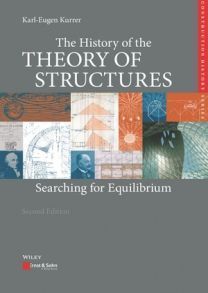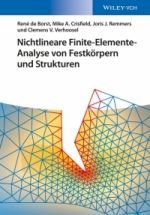About the author
Karl-Eugen Kurrer was born in Heilbronn, Germany, in 1952. After graduating from Stuttgart University of Applied Sciences with a general civil engineering degree in 1973, he worked as a structural timber engineer for Losberger GmbH in Heilbronn.
He then returned to university to study civil engineering and physical engineering sciences at TU Berlin, the city's science and technology university. As a tutor in the Theory of Structures Department at TU Berlin between 1977 and 1981, one of Karl-Eugen Kurrer's most important teaching and learning experiences was grasping the basic principles of structural analysis from the historical point of view. The intention of his handwritten introductory lecture notes on the history of each method of structural analysis was to help students understand that theory of structures, too, is the outcome of a socio-historical everyday process in which they themselves play a part and, in the end, help to shape. Another goal was to create a deeper sense of the motivation for and enjoyment of the learning of structural analysis. It was crucial to overcome the formula-type acquisition of the subject matter by introducing a didactic approach to the fundamentals of theory of structures through their historical appreciation. By 1998 this had evolved into a plea for a historico-genetic approach to the teaching of theory of structures.
His dissertation "Entwicklung der Gewölbetheorie vom 19. Jahrhundert bis zum heutigen Stand der Wissenschaft am Beispiel der Berechnung einer Bogenbrücke" (the development of vault theory from the 19th century to today using the example of structural calculations for an arch bridge) was completed in 1981. Since 1980, his many articles on the history of science and technology in general and construction history in particular have appeared in journals, newspapers, books and exhibition publications.
Karl-Eugen Kurrer completed his PhD - on the internal kinematic and kinetic of tube vibratory mills (advisers: Eberhard Gock, Wolfgang Simonis, Gerd Brunk) - with the highest level of distinction, summa cum laude, at TU Berlin in 1986 and went on to carry out externally funded research on energy efficiency in industry. He contributed to the development of a new eccentric vibratory mill that uses 50% less energy than comparable models. After 1995 the design successfully established itself on the international machine market (US and EU patents). The head of the "Eccentric vibratory mill" team at Clausthal University of Technology, Prof. Dr. Eberhard Gock (1937-2016), received an innovation award ("Technologietransferpreis der Industrie- und Handelskammer Braunschweig") for this work in 1998.
Summaries of the research results from Dr. Kurrer's work at the interface between mechanical process engineering, machine dynamics and raw materials engineering appeared in issues 124 and 282 of series 3 (process engineering) of the progress reports published by the VDI (Association of German Engineers), and also in numerous presentations and journal publications at home and abroad.
Between 1989 and 1995, Dr. Kurrer was employed at the Department of Antenna Design of Telefunken Sendertechnik GmbH (head of department: Dr.-Ing. Peter Bruger) in Berlin as a developer of structural systems for large long-, medium- and short-wave antenna systems. He worked on the further development of Telefunken's own program suite for the calculation, dimensioning and design of cable networks for short-wave antennas according to third-order theory. He also contributed to the design of a rotating steel short-wave curtain antenna.
For nearly 40 years, Karl-Eugen Kurrer has carried out research on the subject of construction history with a special emphasis on theory of structures. Since 1992, he has been involved in the conference series entitled "Between Mechanics and Architecture", which was established by Patricia Radelet-de Grave and Edoardo Benvenuto.
Since 1996, Dr. Kurrer has been Chair of the VDI's Working Group on the History of Technology in Berlin. Between 1996 and February 2018, he was chief editor of Stahlbau and (from 2008) Steel Construction - Design and Research, journals published by Ernst & Sohn (now a Wiley brand). In his capacity as Chair of the History of Technology Working Group, Dr. Kurrer organises, together with Prof. Werner Lorenz (Brandenburg University of Technology Cottbus-Senftenberg), eight lectures on construction history every year for the Deutsches Technikmuseum Berlin. In this capacity, Dr. Kurrer has also organised more than 330 events at the Deutsches Technikmuseum Berlin between 1996 and 2017 - some 140 of them on the history of construction.
For his commitment to the field of the history of technology, Dr. Kurrer was awarded the VDI's "Medal of Honour" in 2016.
Dr. Kurrer was chairman of the scientific committee of the 3rd International Congress on Construction History (20-24 May 2009, Brandenburg University of Technology Cottbus-Senftenberg, Germany).
He has published more than 180 papers and several monographs, e.g. Geschichte der Baustatik (2002, 540pp.), The History of the Theory of Structures. From Arch Analysis to Computational Mechanics (2008, 848pp.) and Geschichte der Baustatik. Auf der Suche nach dem Gleichgewicht (2016, 1184pp.). The first edition of The History of the Theory of Structures was reviewed in 50 international journals.
In recognition of his outstanding scientific achievements in the field of the history of construction, Brandenburg University of Technology Cottbus-Senftenberg awarded him an honorary doctorate on 18 October 2017.



